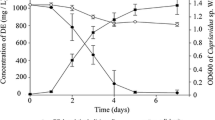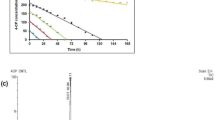Abstract
2-Chloro-4-nitrophenol (2C4NP) is the most common chlorinated nitrophenol pollutant, and its environmental fate is of great concern. Cupriavidus sp. CNP-8, a Gram-negative bacterium, has been reported to degrade 2C4NP via the 1,2,4-benzenetriol (BT) pathway, significantly different from the (chloro)hydroquinone pathways reported in all other Gram-negative 2C4NP-utilizers. Herein, the BT pathway of the catabolism of 2C4NP in this strain was characterized at the molecular, biochemical, and genetic levels. The hnp gene cluster was suspected to be involved in the catabolism of 2C4NP because the hnp genes are significantly upregulated in the 2C4NP-induced strain CNP-8 compared to the uninduced strain. HnpAB, a two-component FAD-dependent monooxygenase, catalyzes the conversion of 2C4NP to BT via chloro-1,4-benzoquinone, with a Km of 2.7 ± 1.1 μΜ and a kcat/Km of 0.17 ± 0.03 μΜ−1 min−1. hnpA is necessary for strain CNP-8 to utilize 2C4NP in vivo. HnpC, a BT 1,2-dioxygenase, was proved to catalyze BT ring-cleavage with formation of maleylacetate by HPLC-MS analysis. Phylogenetic analysis indicated that HnpA likely has different evolutionary origin compared to other functionally identified 2C4NP monooxygenases. To our knowledge, this is the first report revealing the catabolic mechanism of 2C4NP via the BT pathway in a Gram-negative bacterium, increasing our knowledge of the catabolic diversity for microbial 2C4NP degradation at the molecular and biochemical level.







Similar content being viewed by others
References
Arora PK, Jain RK (2011) Pathway for degradation of 2-chloro-4-nitrophenol in Arthrobacter sp. SJCon. Curr Microbiol 63:568–573. https://doi.org/10.1007/s00284-011-0022-2
Arora PK, Jain RK (2012) Metabolism of 2-chloro-4-nitrophenol in a gram negative bacterium, Burkholderia sp. RKJ 800. PLoS One 7:e38676. https://doi.org/10.1371/journal.pone.0038676
Arora PK, Sasikala C, Ramana Ch V (2012) Degradation of chlorinated nitroaromatic compounds. Appl Microbiol Biotechnol 93:2265–2277. https://doi.org/10.1007/s00253-012-3927-1
Arora PK, Srivastava A, Garg SK, Singh VP (2018) Recent advances in degradation of chloronitrophenols. Bioresour Technol 250:902–909. https://doi.org/10.1016/j.biortech.2017.12.007
Bradford MM (1976) A rapid and sensitive method for the quantitation of microgram quantities of protein utilizing the principle of protein-dye binding. Anal Biochem 72:248–254
Chen YF, Chao H, Zhou NY (2014) The catabolism of 2,4-xylenol and p-cresol share the enzymes for the oxidation of para-methyl group in Pseudomonas putida NCIMB 9866. Appl Microbiol Biotechnol 98:1349–1356. https://doi.org/10.1007/s00253-013-5001-z
Ghosh A, Khurana M, Chauhan A, Takeo M, Chakraborti AK, Jain RK (2010) Degradation of 4-nitrophenol, 2-chloro-4-nitrophenol, and 2,4-dinitrophenol by Rhodococcus imtechensis strain RKJ300. Environ Sci Technol 44:1069–1077. https://doi.org/10.1021/es9034123
Hall TA (1999) BioEdit: a user-friendly biological sequence alignment editor and analysis program for Windows 95/98/NT. Nucleic Acids Symp Ser 41:95–98
Hubner A, Danganan CE, Xun L, Chakrabarty AM, Hendrickson W (1998) Genes for 2,4,5-trichlorophenoxyacetic acid metabolism in Burkholderia cepacia AC1100: characterization of the tftC and tftD genes and locations of the tft operons on multiple replicons. Appl Environ Microbiol 64:2086–2093
Kadiyala V, Spain JC (1998) A two-component monooxygenase catalyzes both the hydroxylation of p-nitrophenol and the oxidative release of nitrite from 4-nitrocatechol in Bacillus sphaericus JS905. Appl Environ Microbiol 64:2479–2484
Kitagawa W, Kimura N, Kamagata Y (2004) A novel p-nitrophenol degradation gene cluster from a gram-positive bacterium, Rhodococcus opacus SAO101. J Bacteriol 186:4894–4902. https://doi.org/10.1128/JB.186.15.4894-4902.2004
Li YY, Liu H, Xu Y, Zhou NY (2019) A two-component monooxygenase initiates a novel 2-bromo-4-nitrophenol catabolic pathway in newly isolated Cupriavidus sp. strain NyZ375. Int Biodeterior Biodegrad 140:99–105
Liu H, Wang SJ, Zhou NY (2005) A new isolate of Pseudomonas stutzerithat degrades 2-chloronitrobenzene. Biotechnol Lett 27:275–278. https://doi.org/10.1007/s10529-004-8293-3
Liu PP, Zhang JJ, Zhou NY (2010) Characterization and mutagenesis of a two-component monooxygenase involved in para-nitrophenol degradation by an Arthrobacter strain. Int Biodeterior Biodegrad 64:293–299.https://doi.org/10.1016/j.ibiod.2010.03.001
Liu H, Wang SJ, Zhang JJ, Dai H, Tang H, Zhou NY (2011) Patchwork assembly of nag-like nitroarene dioxygenase genes and the 3-chlorocatechol degradation cluster for evolution of the 2-chloronitrobenzene catabolism pathway in Pseudomonas stutzeri ZWLR2-1. Appl Environ Microbiol 77:4547–4552. https://doi.org/10.1128/AEM.02543-10
Livak KJ, Schmittgen TD (2001) Analysis of relative gene expression data using real-time quantitative PCR and the 2−ΔΔCT Method. Methods 25:402–408. https://doi.org/10.1006/meth.2001.1262
Louie TM, Webster CM, Xun L (2002) Genetic and biochemical characterization of a 2,4,6-trichlorophenol degradation pathway in Ralstonia eutropha JMP134. J Bacteriol 184:3492–3500. https://doi.org/10.1128/jb.184.13.3492-3500.2002
Min J, Zhang JJ, Zhou NY (2014) The gene cluster for para-nitrophenol catabolism is responsible for 2-chloro-4-nitrophenol degradation in Burkholderia sp. strain SJ98. Appl Environ Microbiol 80:6212–6222. https://doi.org/10.1128/AEM.02093-14
Min J, Lu Y, Hu XK, Zhou NY (2016a) Biochemical characterization of 3-methyl-4-nitrophenol degradation in Burkholderia sp. strain SJ98. Front Microbiol 7:791. https://doi.org/10.3389/Fmicb.2016.00791
Min J, Zhang JJ, Zhou NY (2016b) A two-component para-nitrophenol monooxygenase initiates a novel 2-chloro-4-nitrophenol catabolism pathway in Rhodococcus imtechensis RKJ300. Appl Environ Microbiol 82:714–723. https://doi.org/10.1128/Aem.03042-15
Min J, Chen W, Wang J, Hu X (2017) Genetic and biochemical characterization of 2-chloro-5-nitrophenol degradation in a newly isolated bacterium, Cupriavidus sp. strain CNP-8. Front Microbiol 8:1778. https://doi.org/10.3389/fmicb.2017.01778
Min J, Wang J, Chen W, Hu X (2018) Biodegradation of 2-chloro-4-nitrophenol via a hydroxyquinol pathway by a Gram-negative bacterium, Cupriavidus sp. strain CNP-8. AMB Exp 8:43. https://doi.org/10.1186/s13568-018-0574-7
Min J, Chen W, Hu X (2019) Biodegradation of 2,6-dibromo-4-nitrophenol by Cupriavidus sp. strain CNP-8: kinetics, pathway, genetic and biochemical characterization. J Hazard Mater 361:10–18. https://doi.org/10.1016/j.jhazmat.2018.08.063
Pandey J, Heipieper HJ, Chauhan A, Arora PK, Prakash D, Takeo M, Jain RK (2011) Reductive dehalogenation mediated initiation of aerobic degradation of 2-chloro-4-nitrophenol (2C4NP) by Burkholderia sp. strain SJ98. Appl Microbiol Biotechnol 92:597–607. https://doi.org/10.1007/s00253-011-3254-y
Perry LL, Zylstra GJ (2007) Cloning of a gene cluster involved in the catabolism of p-nitrophenol by Arthrobacter sp. strain JS443 and characterization of the p-nitrophenol monooxygenase. J Bacteriol 189:7563–7572. https://doi.org/10.1128/JB.01849-06
Pimviriyakul P, Thotsaporn K, Sucharitakul J, Chaiyen P (2017) Kinetic mechanism of the dechlorinating Flavin-dependent monooxygenase HadA. J Biol Chem 292:4818–4832. https://doi.org/10.1074/jbc.M116.774448
Shen W, Liu W, Zhang J, Tao J, Deng H, Cao H, Cui Z (2010) Cloning and characterization of a gene cluster involved in the catabolism of p-nitrophenol from Pseudomonas putida DLL-E4. Bioresour Technol 101:7516–7522. https://doi.org/10.1016/j.biortech.2010.04.052
Takeo M, Murakami M, Niihara S, Yamamoto K, Nishimura M, Kato D, Negoro S (2008) Mechanism of 4-nitrophenol oxidation in Rhodococcus sp. Strain PN1: characterization of the two-component 4-nitrophenol hydroxylase and regulation of its expression. J Bacteriol 190:7367–7374. https://doi.org/10.1128/JB.00742-08
Tamura K, Stecher G, Peterson D, Filipski A, Kumar S (2013) MEGA6: molecular evolutionary genetics analysis version 6.0. Mol Biol Evol 30:2725–2729. https://doi.org/10.1093/molbev/mst197
Tiwari J, Naoghare P, Sivanesan S, Bafana A (2017) Biodegradation and detoxification of chloronitroaromatic pollutant by Cupriavidus. Bioresour Technol 223:184–191. https://doi.org/10.1016/j.biortech.2016.10.043
Wang L, Gao YZ, Zhao H, Xu Y, Zhou NY (2019) Biodegradation of 2-bromonitrobenzene by Pseudomonas stutzeri ZWLR2-1. Int Biodeterior Biodegradation 138:87–91. https://doi.org/10.1016/j.ibiod.2018.12.008
Wei Q, Liu H, Zhang JJ, Wang SH, Xiao Y, Zhou NY (2010) Characterization of a para-nitrophenol catabolic cluster in Pseudomonas sp. strain NyZ402 and construction of an engineered strain capable of simultaneously mineralizing both para- and ortho-nitrophenols. Biodegradation 21:575–584. https://doi.org/10.1007/s10532-009-9325-4
Xun LY, Webster CM (2004) A monooxygenase catalyzes sequential dechlorinations of 2,4,6-trichlorophenol by oxidative and hydrolytic reactions. J Biol Chem 279:6696–6700. https://doi.org/10.1074/jbc.M312072200
Yamamoto K, Nishimura M, Kato DI, Takeo M, Negoro S (2011) Identification and characterization of another 4-nitrophenol degradation gene cluster, nps, in Rhodococcus sp strain PN1. J Biosci Bioeng 111:687–694. https://doi.org/10.1016/j.jbiosc.2011.01.016
Zhang JJ, Liu H, Xiao Y, Zhang XE, Zhou NY (2009) Identification and characterization of catabolic para-nitrophenol 4-monooxygenase and para-benzoquinone reductase from Pseudomonas sp. strain WBC-3. J Bacteriol 191:2703–2710. https://doi.org/10.1128/JB.01566-08
Zhang S, Sun W, Xu L, Zheng X, Chu X, Tian J, Wu N, Fan Y (2012) Identification of the para-nitrophenol catabolic pathway, and characterization of three enzymes involved in the hydroquinone pathway, in Peudomonas sp. 1-7. BMC Microbiol 12:27. https://doi.org/10.1186/1471-2180-12-27
Funding
This work was supported by the National Natural Science Foundation of China (No. 31600085), the State’s Key Project of Research and Development Plan (2016YFC1402300), the Foreword Key Priority Research Program of Chinese Academy of Sciences (QYZDB-SSW-DQC013), the Yantai Science and Technology Project (2017ZH092), and the State Key Laboratory of Microbial Metabolism, Shanghai JiaoTong University (MMLKF17-04).
Author information
Authors and Affiliations
Corresponding author
Ethics declarations
Conflict of interest
The authors declare that they have no conflict of interest.
Ethical approval
This article does not contain any studies with human participants or animals performed by authors.
Additional information
Publisher’s note
Springer Nature remains neutral with regard to jurisdictional claims in published maps and institutional affiliations.
Electronic supplementary material
ESM 1
(PDF 318 kb)
Rights and permissions
About this article
Cite this article
Min, J., Xu, L., Fang, S. et al. Molecular and biochemical characterization of 2-chloro-4-nitrophenol degradation via the 1,2,4-benzenetriol pathway in a Gram-negative bacterium. Appl Microbiol Biotechnol 103, 7741–7750 (2019). https://doi.org/10.1007/s00253-019-09994-7
Received:
Revised:
Accepted:
Published:
Issue Date:
DOI: https://doi.org/10.1007/s00253-019-09994-7




